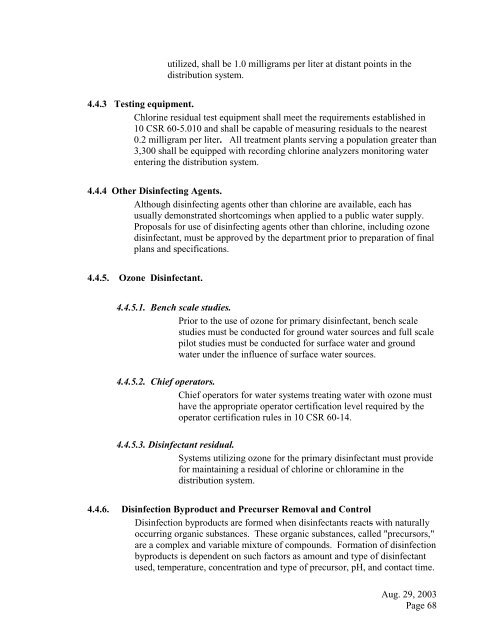Design Guide for Community Water Systems - The Water, Sanitation ...
Design Guide for Community Water Systems - The Water, Sanitation ...
Design Guide for Community Water Systems - The Water, Sanitation ...
Create successful ePaper yourself
Turn your PDF publications into a flip-book with our unique Google optimized e-Paper software.
utilized, shall be 1.0 milligrams per liter at distant points in thedistribution system.4.4.3 Testing equipment.Chlorine residual test equipment shall meet the requirements established in10 CSR 60-5.010 and shall be capable of measuring residuals to the nearest0.2 milligram per liter. All treatment plants serving a population greater than3,300 shall be equipped with recording chlorine analyzers monitoring waterentering the distribution system.4.4.4 Other Disinfecting Agents.Although disinfecting agents other than chlorine are available, each hasusually demonstrated shortcomings when applied to a public water supply.Proposals <strong>for</strong> use of disinfecting agents other than chlorine, including ozonedisinfectant, must be approved by the department prior to preparation of finalplans and specifications.4.4.5. Ozone Disinfectant.4.4.5.1. Bench scale studies.Prior to the use of ozone <strong>for</strong> primary disinfectant, bench scalestudies must be conducted <strong>for</strong> ground water sources and full scalepilot studies must be conducted <strong>for</strong> surface water and groundwater under the influence of surface water sources.4.4.5.2. Chief operators.Chief operators <strong>for</strong> water systems treating water with ozone musthave the appropriate operator certification level required by theoperator certification rules in 10 CSR 60-14.4.4.5.3. Disinfectant residual.<strong>Systems</strong> utilizing ozone <strong>for</strong> the primary disinfectant must provide<strong>for</strong> maintaining a residual of chlorine or chloramine in thedistribution system.4.4.6. Disinfection Byproduct and Precurser Removal and ControlDisinfection byproducts are <strong>for</strong>med when disinfectants reacts with naturallyoccurring organic substances. <strong>The</strong>se organic substances, called "precursors,"are a complex and variable mixture of compounds. Formation of disinfectionbyproducts is dependent on such factors as amount and type of disinfectantused, temperature, concentration and type of precursor, pH, and contact time.Aug. 29, 2003Page 68
















